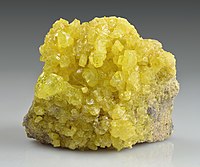
Photo from wikipedia
Abstract The sulfur-containing volatile organic compounds (VOCs) in the storage tank VOCs will produce SOX during the catalytic combustion process, SOX can easily react with Pd species in palladium-based catalysts… Click to show full abstract
Abstract The sulfur-containing volatile organic compounds (VOCs) in the storage tank VOCs will produce SOX during the catalytic combustion process, SOX can easily react with Pd species in palladium-based catalysts to form stable sulfates (PdSO3 and PdSO4), resulting in permanently deactivating the palladium-based catalysts. In this paper, the Pt/γ-Al2O3, Pd/γ-Al2O3, Pd–Pt/γ-Al2O3 and Pd–Pt/MgO/γ-Al2O3 mesoporous catalysts were prepared using an incipient wetness impregnation method. The anti-sulfur dioxide poisoning performance of the catalysts and the mechanism of anti-sulfur dioxide poisoning of Pd–Pt/γ-Al2O3 and Pd–Pt/MgO/γ-Al2O3 catalysts were investigated. The SOX competitive adsorbent is highly dispersed on the catalyst surface, which makes the formed sulfate highly dispersed on the catalyst surface, thereby reducing the thermal decomposition temperature of the sulfate. The results show that the Pd species in Pd/γ-Al2O3 catalyst can easily react with SOX to form stable palladium sulfate species, causing permanent deactivation of the catalyst. The electronic modulation effect between Pd and Pt can reduce the adsorption performance of Pd–Pt active components on sulfur dioxide, and also can prevent the reaction of Pd species with SOX. The added MgO can form MgAl2O4 spinel with the γ-Al2O3 support, and the MgAl2O4 spinel can compete with Pd–Pt active components for SOX adsorption, further protecting Pd–Pt active components from SOX. After catalyst regeneration, the sulfur content of Pd–Pt/MgO/γ-Al2O3 catalyst was greatly reduced, and the regenerated catalyst maintained the catalytic performance of pre-reaction catalyst.
Journal Title: International Journal of Hydrogen Energy
Year Published: 2020
Link to full text (if available)
Share on Social Media: Sign Up to like & get
recommendations!